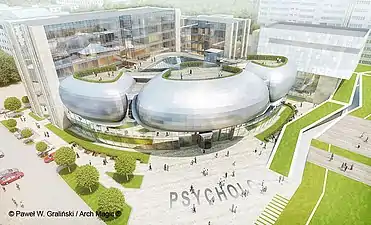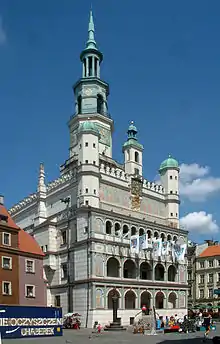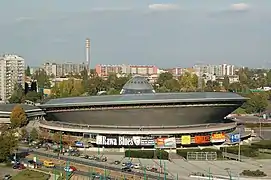Following is a list of notable Polish architects and architects from Poland ordered by architectural period.
Gothic
Renaissance and Mannerism
- Jakub Balin[1]
- Bartolommeo Berrecci (Bartłomiej Berecci) (c. 1480–1537)
- Krzysztof Bonadura Starszy (1582–1670)[2]
- Santi Gucci (c. 1530–1599)
- Jan Michałowicz (1530–1578)[3]
- Bernardo Morando (c. 1540–1600)
- Giovanni Battista di Quadro (born 1590)
- Gabriel Słoński (1520–1598)[3]
- Jan Strakowski[4] (1567–1642)
Baroque
- Krzysztof Arciszewski (1592–1656)
- Kacper Bażanka[5] (c. 1689–1726)
- Piotr Beber[2]
- Jan Frankiewicz[1]
- Christof Marselis (1670s–1731)
- Bartłomiej Nataniel Wąsowski[1] (1617–1687)
- Tylman van Gameren (1632–1706)
- Jan Zaor
18th century: Post Baroque, Rococo and Classical
- Chrystian Piotr Aigner (1756–1841)
- Józef Boretti (1746–1849)
- Jakub Fontana (1710–1773)
- Paweł Giżycki[1] (1692–1762)
- Jan Krzysztof Glaubitz (1700–1767)
- Faustyn Grodzicki[1]
- Wawrzyniec Gucewicz (1753–1798)
- Jan Christian Kamsetzer (1753–1795)
- Józef Karsznicki[1]
- Marcin Knackfus (ca. 1742–ca. 1821)
- Franciszek Koźmiński[1]
- Jakub Kubicki (1758–1833)
- Fryderyk Albert Lessel (1767–1822)
- Andrzej Melenski (1766–1833)[6]
- Dominik Merlini (1730–1797)
- Józef Feliks Rogaliński[1]
- Antoni Solari
- Bonawentura Solari
- Efraim Szreger (1727–1783)
- Stanisław Zawadzki (1743–1806)
- Szymon Bogumił Zug (1733–1807)
- Tomasz Żebrowski (18th century)[1]
19th century: Historicism and Eclecticism

- Julian Ankiewicz (1820–1903)
- Bronisław Brochwicz-Rogoyski (1861–1921)
- Franciszek Chełmiński (1862–1932)
- Edward Cichocki (1833–1899)
- Julian Cybulski[7]
- Tomasz Bohdanowicz-Dworzecki (1859–1920)
- Józef Pius Dziekoński[8] (1844–1927)
- Władysław Ekielski[7] (1855–1927)
- Zygmunt Gorgolewski (1845–1903)
- Józef Gosławski (1865–1904)
- Stanisław Grochowicz
- Władysław Hirszel (1831–1889)
- Juliusz Hochberger[7]
- Józef Huss (1846–1904)
- Józef Kajetan Janowski[7] (1832–1914)
- Alfred Kamienobrodzki[7] (1844–1922)
- Karol Knaus
- Feliks Księżalski (1820–1884)[7]
- Gustaw Landau-Gutenteger (1879–1917)
- Dawid Lande (1868–1928)
- Józef Grzegorz Lessel (1802–1844)
- Wiesław Lisowski (1884–1954)
- Antoni Łuszkiewicz (1838–1886)[9]
- Michał Łużecki[7] (1868 – after 1939)
- Hilary Majewski (1838–1892)
- Karol Majewski (1824–1897)[10]
- Enrico Marconi (1792–1863)
- Władysław Marconi (1848–1915)
- Franciszek Miechowicz (1786–1852)[11]
- Maciej Moraczewski[7] (1840–1928)
- Michael Novosielski – architect of the King's Theatre in London[12]
- Sławomir Odrzywolski-Nałęcz[7] (1846–1933)
- Józef Orłowski
- Tomasz Pajzderski (1864–1908)
- Józef Plośko
- Karol Podczaszyński (1790–1860)
- Bolesław Podczaszyński (1822–1876) – son of Karol Podczaszyński
- Filip Pokutyński (1829–1879)[7][9]
- Tomasz Pryliński (1847–1895)[7][9]
- Władysław Sadłowski (1869–1940)
- Franciszek Skowron[7]
- Roger Sławski (1871–1963)
- Józef Sosnowski[7]
- Stefan Szyller[7] (1857–1933)
- Aleksander Szymkiewicz[13]
- Hipolit Śliwiński[7] (1866–1932)
- Leopold Śmieciński
- Teodor Talowski (1857–1910)
- Julian Zachariewicz (1837–1898)
- Jan Zawiejski (1854–1922)
- Adolf Zeligson
- Józef Sare (1850–1929)[9]
- Karol Zaremba (1846–1897)[9]
- Jan Sas Zubrzycki (1860–1935)
- Stefan Żołdani
20th century to present: Modern
A–B

A. Chołdzyński: Plac Wilsona metro station of the Warsaw Metro
- Hanna Adamczewska-Wejchert (1920-1996)
- Stanisław Adamski (1875-1967)
- Roman Bandurski[14][15] (1874–1949)
- Lotte Beese (1903-1988)
- Barbara Brukalska (1899-1980)
- Stefan Bryła (1886–1943)
C–D
- Adolf Ciborowski[16] (1918–1987)
- Jan Cieśliński[17] (1899–1967)
- Gerard Ciołek (1909-1966)
- Józef Czajkowski (1872-1947)
- Władysław Derdacki[7] (1882–1951)
E–F
- Roman Feliński (1886-1953)
- Stanisław Fiszer (1769-1812)
G–I

Paweł Graliński: Faculty of Psychology, University of Warsaw
- Zofia Garlińska-Hansen (1924–2013)
- Henryk Julian Gay (Henryk Gaj) (1875–1936)[18]
- Vladislav Gorodetsky (born Leszek Dezydery Władysław Horodecki)(1863–1930)[19]
- Jadwiga Grabowska-Hawrylak (1920–2018)
- Paweł Graliński (born 1961)
- Stanisław Hempel[20] (1892–1954)
- Jerzy Hryniewiecki[21] (1909–1988)
J–K

C. Korn: The main post office in Bielsko-Biała
- Stanisław Jankowski (1911-2002)
- Ryszard Jurkowski (born 1945)
- Ignacy Kędzierski[7] (1877–1968)
- Zygmunt Kędzierski[7] (1839–1924)
- Jacek Krenz (born 1948)
- Bogdan Krzyżanowski[7]
- Stefan Kuryłowicz (1949–2011)
L–M

M. Leykam: DT "Orąglak" in Poznań
- Bohdan Lachert[22] (1900–1987)
- Zbigniew Brochwicz-Lewiński[7][15] (1877–1951)
- Józef Masłowski[7] (1931-2020)
- Franciszek Mączyński[7] (1874–1947)
- Witold Minkiewicz[7] (1880–1961)
- Kazimierz Mokłowski[7] (1869-1905)
N–O
- Maciej Nowicki (1910–1950)[23]
- Tadeusz Obmiński[7] (1874–1932)
P–Q
- Sylwester Pajzderski[24] (1876–1953)
- Włodzimierz Podhorodecki[7] (1859-1923)
- Juliusz Prandecki (1928-2016)
- Georg Przyrembel (1885–1956)[25]
- Bohdan Pniewski[26] (1897–1965)
R–S

Emanuel Rost: Town Hall in Bielsko-Biała
- Wincenty Rawski[7] (1850-1927)
- Stanisław Ryniak (1915–2004)
- Halina Skibniewska (1921-2011)
- Roger Sławski (1871–1963)[17]
- Jerzy Sołtan (1913–2005)
- Oskar Sosnowski (1880-1939)
- Tadeusz Stryjeński (1849–1943)[9][27]
- Szymon Syrkus (1893–1964)[23]
- Helena Syrkus[28] (1900–1982)
- Józef Szanajca (1902-1939)[22]
- Witold Szolginia[7] (1923–1996)
- Adolf Szyszko-Bohusz[7] (1883–1948)
T–U
- Czesław Thullie[15] (1886–1976)
- Michał Ulam[7] (1879–1938)
- Kazimierz Ulatowski (1884–1975)[17]
- Tomasz Urbanowicz (born 1959)
V–Z
- Jan Koszczyc-Witkiewicz (1881–1958)
- Kazimierz Wyczyński (1876-1923)[27]
- Wojciech Zabłocki (1930–2020)
- Alfred Zachariewicz (1871-1937)
- Jan Zachwatowicz (1900–1983)
- Stanisław Żaryn (1913–1964), architect and monument conservator
- Zbigniew Zieliński (1907–1968)[17]
- Wiktor Zin (1925–2007)
- Juliusz Żórawski (1898-1967)
See also
References
- 1 2 3 4 5 6 7 8 9 Betlej, Andrezej (2011). "Jesuits Architecture in Polish-Lithuanian Commonwealth in 1564–1772". [In:] La Arquitectura Jesuítica. ed. María Isabel Álvaro. Saragossa. pp. 292, 294, 298.
- 1 2 Miłobędzki, Adam (1980). Polish Architecture of 17th Century. Vol. 1. Polish Scientific Publishers PWN. pp. 495, 499. OCLC 640579340.
- 1 2 Dvornik, Francis (1962). The Slavs in European History and Civilization. Rutgers University Press. p. 306.
- ↑ Cieślak, Edmund; Biernat, Czesław (1995). History of Gdańsk. Fundacja Biblioteki Gdańskiej. p. 173.
- ↑ Cohen, Gary B.; Szabo, Franz A. J. (2008). Embodiments of Power: Building Baroque Cities in Europe. Berghahn Books. p. 103.
- ↑ Hamm, Michael F. (1995). Kiev: A Portrait, 1800–1917. Princeton University Press. p. 56.
- 1 2 3 4 5 6 7 8 9 10 11 12 13 14 15 16 17 18 19 20 21 22 23 24 25 26 27 28 29 30 Jakub, Lewicki (2005). Między tradycją a nowoczesnością: architektura Lwowa lat 1893–1918 (in Polish). Neriton.
- ↑ Muthesius, Stefan (1994). Art, Architecture and Design in Poland, 966–1990: An Introduction. K.R. Langewiesche Nachfolger, H. Köster Verlagsbuchhandlung. p. 56.
- 1 2 3 4 5 6 Waszczyszyn, Elżbieta. "The 19th Century Medical Clinic of Collegium of the Jagiellonian University in Kraków. An Outline of Conservation Problems in the Light of Requirements of a Modern University Hospital." Conservation News. 27/2010. p. 54.
- ↑ Lieven, Dominic (2006). The Cambridge History of Russia: Volume 2, Imperial Russia, 1689–1917. Cambridge University Press. p. 182.
- ↑ Bazylow, Ludwik (1985). Historia Rosji. Vol. 1. Polish Scientific Publishers PWN. p. 243.
- ↑ Stanley-Little, Cerita (2009). The Great Lablache: Nineteenth Century Operatic Superstar His Life and His Times. Xlibris. p. 111.
- ↑ Doijašvili, Manana (2008). The Vano Saradjishvili Tbilisi State Conservatoire, 1917–2007. Nova Publishers. p. 87.
- ↑ Grodziska, Karolina; Krasnowolski, Bogusław (2007). Cracow: The Heritage of Centuries. Historical Museum of the City of Cracow. p. 43.
- 1 2 3 Prokopovych, Markian (2009). Habsburg Lemberg: Architecture, Public Space, and Politics in the Galician Capital, 1772–1914. Purdue University Press. pp. 157, 179.
- ↑ Awotona, Adenrele A. (1997). Reconstruction After Disaster: Issues and Practices. Ashgate Publishing. p. 75.
- 1 2 3 4 Faraldo, José M. (2008). "Medieval Socialist Artifacts. Architecture and Discourses of National Identity in Provincial Poland (1945–1960)" in Europe, Nationalism, Communism: Essays on Poland. Peter Lang. pp. 23–24, 28.
- ↑ Chrościcki, Juliusz A.; Rottermund, Andrzej (1978). Atlas of Warsaw's Architecture. Arkady. p. 61.
- ↑ Magocsi, Paul Robert (2010). History of Ukraine: The Land and Its Peoples. University of Toronto Press. p. 357.
- ↑ Kohlrausch, Martin (2012). "'Houses of Glass'. Modern Architecture and the Idea of Community in Poland". [In:] Heyninckx, Rajesh; Avermaete, Tom. Making a New World: Architecture & Communities in Interwar Europe. Leuven University Press. p. 99.
- ↑ Crowley, David (1992). National Style and Nation-State: Design in Poland from the Vernacular Revival to the International Style. Manchester University Press. p. 106.
- 1 2 Paczek, Adolf K. (1982). Macmillan Encyclopedia of Architects Vol. 2. Free Press. p. 597.
- 1 2 Mallgrave, Harry Francis (2005). Modern Architectural Theory: A Historical Survey, 1673–1968. Cambridge University Press. pp. 267, 339.
- ↑ Stefanski, Krzysztof (2003). "Polish Ecclesiastical Architecture of the Early 20th New Form and National Obligations". Centropa: A Journal of Central European Architecture and Related Arts. p. 242.
- ↑ Segawa, Hugo (2013). Architecture of Brazil. Springer. pp. 24, 31.
- ↑ Leśnikowski, Wojciech G.; Šlapeta, Vladimir (1996). East European Modernism: Architecture in Czechoslovakia, Hungary, and Poland Between the Wars 1919–1939 Rizzoli. pp. 199, 217.
- 1 2 Blau, Eve; Platzer, Monika (1999). Shaping the Great City: Modern Architecture in Central Europe, 1890–1937. Prestel. p. 153.
- ↑ Olsen, Kirstin (1994). Chronology of Women's History. Greenwood Publishing Group. p. 166.
This article is issued from Wikipedia. The text is licensed under Creative Commons - Attribution - Sharealike. Additional terms may apply for the media files.




